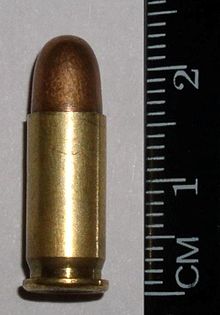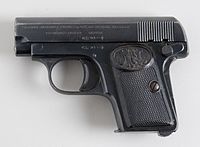.25 ACP
| .25 ACP | ||||||||||||||||||||
|---|---|---|---|---|---|---|---|---|---|---|---|---|---|---|---|---|---|---|---|---|
 .25 ACP cartridge with scale | ||||||||||||||||||||
| Type | Pistol | |||||||||||||||||||
| Place of origin | United States and Belgium | |||||||||||||||||||
| Production history | ||||||||||||||||||||
| Designer | John Browning | |||||||||||||||||||
| Designed | 1905 | |||||||||||||||||||
| Produced | 1905–present | |||||||||||||||||||
| Specifications | ||||||||||||||||||||
| Case type | Semi-rimmed, straight | |||||||||||||||||||
| Bullet diameter | .2512 in (6.38 mm) | |||||||||||||||||||
| Land diameter | .2429 in (6.17 mm) | |||||||||||||||||||
| Neck diameter | .276 in (7.0 mm) | |||||||||||||||||||
| Base diameter | .278 in (7.1 mm) | |||||||||||||||||||
| Rim diameter | .302 in (7.7 mm) | |||||||||||||||||||
| Rim thickness | .043 in (1.1 mm) | |||||||||||||||||||
| Case length | .615 in (15.6 mm) | |||||||||||||||||||
| Overall length | .910 in (23.1 mm) | |||||||||||||||||||
| Rifling twist | 1:16 | |||||||||||||||||||
| Primer type | Small pistol | |||||||||||||||||||
| Maximum pressure | 25,000 psi (170 MPa) | |||||||||||||||||||
| Maximum CUP | 25,000[1] CUP | |||||||||||||||||||
| Ballistic performance | ||||||||||||||||||||
| ||||||||||||||||||||
| Test barrel length: 2" Source(s): Guns & Ammo Magazine Buffalo Bore | ||||||||||||||||||||
The .25 ACP (Automatic Colt Pistol), also known as the .25 Auto, .25 Automatic, or 6.35×16mmSR) is a semi-rimmed, straight-walled centerfire pistol cartridge introduced by John Browning in 1905 alongside the Fabrique Nationale M1905 pistol.
Design and history
[edit]The .25 ACP was designed because .25-caliber was the smallest John Browning could go while still retaining a centerfire primer pocket, which would be more reliable for self-defense than rimfire primers. As such, the .25 ACP allows for a very compact and lightweight gun, usually a semi-automatic pocket pistol.[2] The .25 ACP was hugely popular after its introduction, with many millions of pocket .25 "mouse guns" being offered on the market.
Following the Gun Control Act of 1968, most foreign .25 pistols were too small to be imported, however some domestic manufacturers continued to build guns in the caliber. No new .25 ACP pocket pistols have been developed in well over a decade, and it is unlikely that this will change anytime soon. The most common pocket pistols in the United States today are in .22, .380 or 9mm.[3]
The cartridge is of semi-rimmed design meaning that the rim protrudes slightly beyond the diameter of the base of the cartridge so the cartridge can headspace on the rim.[4] This semi-rimmed design allows for it to be used in revolvers. Although rare, .25 ACP revolvers were produced in the early twentieth century by Belgian, French, and German gunmakers such as Adolph Frank and Decker.[5] In the late twentieth century, Bowen Classic Arms produced a custom Smith & Wesson revolver in .25 ACP.[6]
Performance
[edit]The .25 ACP is viewed by some, including Gun Digest magazine, as a solid choice for personal defense handguns due to its small size, low recoil, centerfire primer and effective penetration.[7][8][9][10] Because of the delicate nature of the majority of .25-caliber automatics, the vast majority of commercial .25 ACP loads are not loaded as powerfully as they could be. However, more modern ammunition offerings from manufacturers such as Buffalo Bore hard cast lead, Federal "Punch" and Hornady Critical Defense are designed to be closer to the cartridge's full potential.[11][12][13]
The reputation of the .25 ACP has long suffered from the cartridge only being offered in low-capacity pocket pistols with 2-inch barrels. This short barrel length limits the velocity and energy that a .25 can offer and contributes to the myth that the .25 ACP is less powerful than the .22 Long Rifle. The .22 LR is a rifle cartridge and, as such, is typically tested in rifle-length barrels, which is why the .22 LR appears to be more powerful than the .25 ACP. In reality, the .25 ACP tends to perform better than the .22 LR in pocket pistols, and the maximum pressure of the .25 is higher than the .22.[14][15][16]
-
FN 1905/6
-
Modern jacketed hollow point loads for 6.35mm/.25 cal.
-
The Walther Model 9 pistol uses 6.35mm
-
Raven MP-25 .25 ACP chrome with faux mother of pearl grips and push up safety
-
Colt Model 1908 Vest Pocket used .25 ACP
See also
[edit]- 6 mm caliber – Firearm cartridge classification
- Table of handgun and rifle cartridges
References
[edit]- ^ Saami pressures. (n.d.). Retrieved May 3, 2023, from https://leverguns.com/articles/saami_pressures.htm
- ^ https://www.guns.com/news/2024/03/28/25-acp-auto-mouse-gun-caliber-bullet-browning-history/
- ^ https://gunmagwarehouse.com/blog/all-you-need-to-know-about-the-25-acp/
- ^ *Wilson, R. K. Textbook of Automatic Pistols. Plantersville, SC: Small Arms Technical Publishing Company, 1943. p. 258. ISBN 978-0-935632-89-7.
- ^ Hogg, Ian; Walter, John (2004-08-29). Pistols of the World. David & Charles. ISBN 0873494601.
- ^ Bowen, Hamilton. The Custom Revolver. Privately printed, 2001. ISBN 978-0-9713366-0-5.
- ^ Jerry Ahern (2010), Gun Digest Buyer's Guide to Concealed-Carry Handguns, Gun Digest Books, pp. 19–20, ISBN 978-1-4402-1383-0
- ^ https://www.youtube.com/watch?v=rfycMCuuKxY
- ^ https://gundigest.com/gear-ammo/ammunition/25-acp-the-best-cartridge-for-really-little-guns
- ^ https://trueshotammo.com/academy/is-the-25-acp-any-good/
- ^ https://www.thefirearmblog.com/blog/federal-punch-self-defense-ammo-has-new-25-acp-option-44814382
- ^ https://gunmagwarehouse.com/blog/tested-buffalo-bore-25-acp-60-grain-hard-cast-ammunition/
- ^ https://www.hornady.com/ammunition/handgun/25-auto-35-gr-ftx-critical-defense#!/
- ^ https://www.ammunitiontogo.com/lodge/22lr-vs-25-acp/
- ^ https://nightgalaxy.com/blog/post/25-acp-22lr-comparing-pocket-pistol-calibers-for-concealed-carry
- ^ https://nightgalaxy.com/blog/post/25-acp-22lr-comparing-pocket-pistol-calibers-for-concealed-carry






